

Le theme de leweb paris 2012 the internet of things. Internet of Things Europe 2011. Organisée par Forum Europe, en collaboration avec Analysis Mason, et Council et soutenue par la Commission Européenne, la conférence a été officiellement déclarée ouverte par Rob van Kranenburg, fondateur de Council.
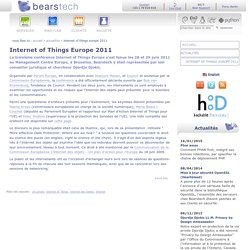
Pendant ces deux jours, les intervenants se sont employés à examiner les opportunités et les risques que l'Internet des objets peut présenter pour le business et les consommateurs. Parmi une quarantaine d'orateurs présents pour l'événement, les keynotes étaient présentées par Neelie Kroes (commissaire européenne en charge de la société numérique), Maria Badia I Couchet (députée au Parlement Européen et rapporteur sur Plan d'Action Internet of Things pour l'UE) et Peter Hustinx (superviseur à la protection des données de l'UE).
Une liste complète des orateurs est disponible sur cette page. Le discours le plus remarquable était celui de Hustinx, qui, lors de sa présentation intitulée " More effective Data Protection: Where are we now? Hors Série MCD : Internet des objets / Internet of things. Un numéro spécial de la revue MCD sur l’internet des objets, en collaboration avec la Fing, le Council for the Internet of Things, Nod-A et l’Epita.
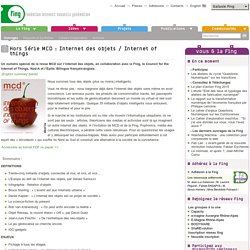
Bilingue français-anglais. (English summary below) Nous sommes tous des objets (plus ou moins) intelligents. Vous ne rêvez pas : nous baignons déjà dans l’Internet des objets sans même en avoir conscience. Les animaux pucés, les produits de consommation tracés, les passeports biométriques et les outils de géolocalisation dessinent un monde où virtuel et réel sont déjà totalement imbriqués. Si le marché et les institutions ont su très vite investir l’informatique ubiquitaire, ils ne sont pas les seuls : artistes, théoriciens des médias et activistes sont là qui imaginent un autre Internet des objets. Accessible au format PDF ou papier >> Are you ready for the Internet of Things? ITU Internet Reports 2005: The Internet of Things. ITU Internet Reports 2005: The Internet of Things is the seventh in the series of "ITU Internet Reports" originally launched in 1997 by the International Telecommunication Union.
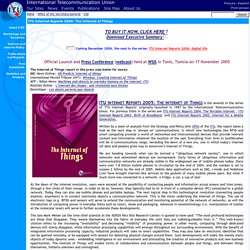
For previous titles in the series see ITU Internet Reports 2004: The Portable Internet , ITU Internet Reports 2003: Birth of Broadband, and ITU Internet Reports 2002: Internet for a Mobile Generation. Written by a team of analysts from the Strategy and Policy Unit (SPU) of the ITU, the report takes a look at the next step in "always on" communications, in which new technologies like RFID and smart computing promise a world of networked and interconnected devices that provide relevant content and information whatever the location of the user.
Everything from tires to toothbrushes will be in communications range, heralding the dawn of a new era, one in which today’s Internet (of data and people) gives way to tomorrow’s Internet of Things. The 4th Annual Internet of Things Europe. You are in: Information > Summary Forum Europe would like to thank all the people and organisations involved in this year's event for all their support.
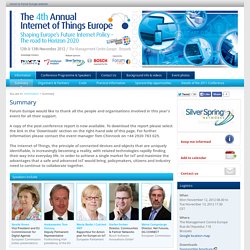
A copy of the post-conference report is now available. To download the report please select the link in the 'Downloads' section on the right-hand side of this page. For further information please contact the event manager Tom Chinnock on +44 2920 783 025. The Internet of Things, the principle of connected devices and objects that are uniquely identifiable, is increasingly becoming a reality, with related technologies rapidly finding their way into everyday life.
Speakers include Neelie Kroes Vice President and EU Commmisioner for Digital Agenda European Commission (video presentation) Stefan Ferber Director, Communities & Partner Networks Bosch Software Innovations GmbH Keynote video presentation by Vice President Kroes at this year's conference Further information Sessions at the conference included: Introduction - Internet of Things Event.
The Internet of Things Is Wildly Insecure — And Often Unpatchable. Illustration: alengo/Getty Images We’re at a crisis point now with regard to the security of embedded systems, where computing is embedded into the hardware itself — as with the Internet of Things.
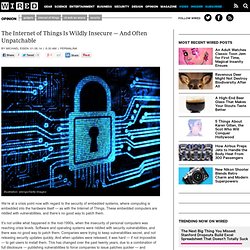
These embedded computers are riddled with vulnerabilities, and there’s no good way to patch them. It’s not unlike what happened in the mid-1990s, when the insecurity of personal computers was reaching crisis levels. Software and operating systems were riddled with security vulnerabilities, and there was no good way to patch them. Companies were trying to keep vulnerabilities secret, and not releasing security updates quickly. But this time the problem is much worse, because the world is different: All of these devices are connected to the Internet. If we don’t solve this soon, we’re in for a security disaster as hackers figure out that it’s easier to hack routers than computers.
To understand the problem, you need to understand the embedded systems market. Hackers are starting to notice.